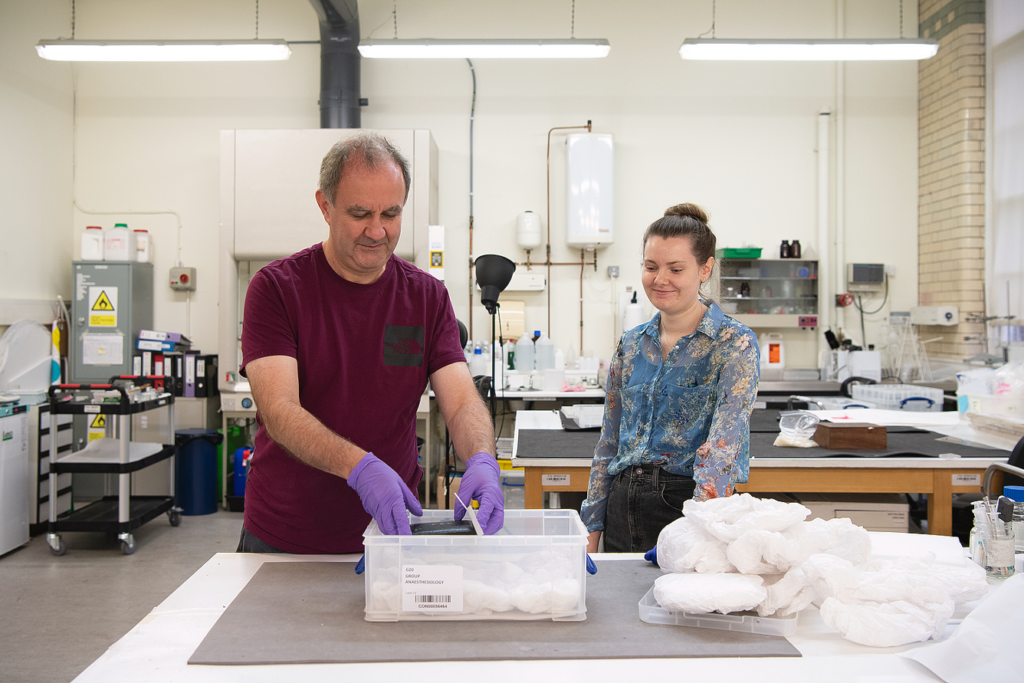Created in 1883, the Royal Red Cross Medal was initially awarded to women ‘for special exertions in providing for the nursing of sick and wounded soldiers and sailors’. In 1976, men also became eligible for consideration.
The first Royal Red Cross Medal was awarded to Florence Nightingale, whose work as a nurse and statistician secured her legacy as a celebrated historical figure. Some of her belongings are cared for by the Science Museum Group, including her moccasins and her parasol.
The Royal Red Cross Medal awarded to Elizabeth Batten, was one of the final objects from the Science Museum Group Collection to leave Blythe House. It was awarded to Elizabeth Batten, Senior Sister in Queen Alexandra’s Imperial Military Nursing Service Reserve at the Royal Free Hospital, for her nursing services during the First World War.

This medal has now been carefully studied, photographed, packed and transported to the National Collections Centre, alongside 300,000 other historical objects. From 2024, these objects can be seen in person through public tours, school and research visits, increasing public access to the collection.
As the collection move comes to an end, Georgina Kavanagh and Zahra Hasnain reflect on the teamwork and the ambition that saw hundreds of thousands of objects be carefully packed to travel from London to our cutting-edge collection management facility in Wiltshire.
GEORGINA KAVANAGH, ASSISTANT CURATOR
I have been lucky enough to experience the Blythe House Decant Project from various perspectives.
In 2018 I volunteered with the Inventory and Photography teams to help capture vital object information and images for the Science Museum Group’s online collection. I then joined the Decant Team, which worked to carefully pack 300,000 objects from the collection. The team and I quickly learned that packing museum collections is nothing like packing to move house! Working with such a variety of objects, from mercury thermometers to marble statues, astronaut food to wax models was a fascinating challenge.

While some objects such as this medal were relatively straight-forward to pack safely, countless others have their own specific requirements. This could be due to fragility, humidity requirements, hazards, loose parts, size, or the culturally sensitive nature of some objects.
Object sizes ranged from a measuring weight the size of a fingernail, to an iron lung. Perhaps the largest object we packed at Blythe House was a heliometer. This refracting telescope required a custom-made crate. In complex cases, we worked closely with many teams for advice, including Conservation, Hazards, Inventory, Photography, Documentation, Curatorial, Registrars and Logistics. Suggestions were always welcome, and support was always available.
As well as the complexities of the objects, Blythe House itself has many quirks that created challenges for the Decant team. Preparing objects for their journey to their new home required strong coordination and new routes – not only that but as some door frames are smaller than others, it also required screwdrivers: it was not unusual to see doors temporarily taken off their hinges to create more wiggle room!
In May 2023, I began my current job as an Assistant Curator. This entails researching our collection and updating object records. This might involve researching records on our collections management system, delving into old photographs or paperwork. While it can be a lot of work to go through old instruction manuals to understand the anatomy of an object, or to track the history of an object through handwritten lists of acquisitions from 50 years ago, I enjoy the responsibility of ensuring our incredible objects are accurately understood.
The more we know about our objects, the more we can share with our visitors! This might be through our online collection , blog posts, or exhibitions and galleries. Working so closely with the collection has allowed me to see hundreds of thousands of objects that aren’t on display, and I am thrilled to help make these more accessible to the public.
ZAHRA HASNAIN, MAJOR PROJECT ADMINISTRATOR
The Royal Red Cross Medal is inscribed with the words ‘Faith’, ‘Hope’ and ‘Charity’, all sentiments that the team working for the Blythe Decant Project have embodied across the five years of unwavering hard work and careful planning that have gone into this process.
As a relative newcomer to the team, it was a privilege to walk around Blythe House and see the objects at such close proximity. This privilege will soon be shared with the public through the National Collections Centre, which will opens for public tours in 2024. It quickly became clear that these were not simply objects being packed into boxes, but representations of the people that created them.
During my first few weeks, I shadowed several of the teams at Blythe, and the sense of community exuded by all my colleagues was one that allowed me to immediately feel part of this monumental undertaking.

While being shown how to carefully pack objects, it was explained to me how objects were packed with sustainability and the environment in mind, with the boxes and packing materials used to pack the collection reused as much as possible.
Along with the Royal Red Cross Medal, there were several other noteworthy objects being packed by the team. Some honorable mentions include a Narwhal tusk, Statham’s Chemical Magic Chemistry set, and a replica of Isaac Newton’s reflecting telescope.
It has been a huge team effort to prepare this incredible collection to move to its new home and increase public access to it, and as the final object leaves the building, I’m reminded of the hard work of everyone who has been a part of the history of Blythe House.

The new facility at the National Collections Centre is due to open in 2024 for tours and research, allowing people to see 80% of the Science Museum Group Collection all under one roof for the very first time.